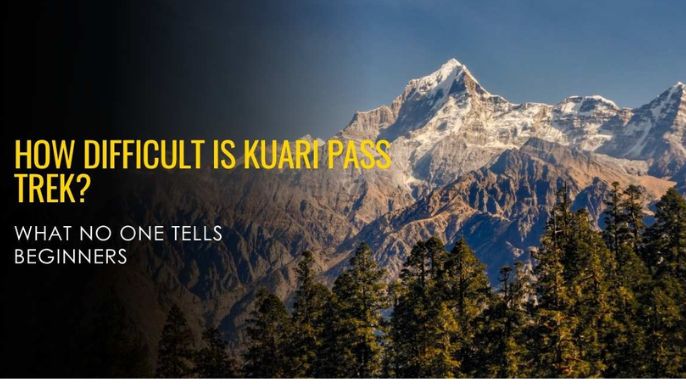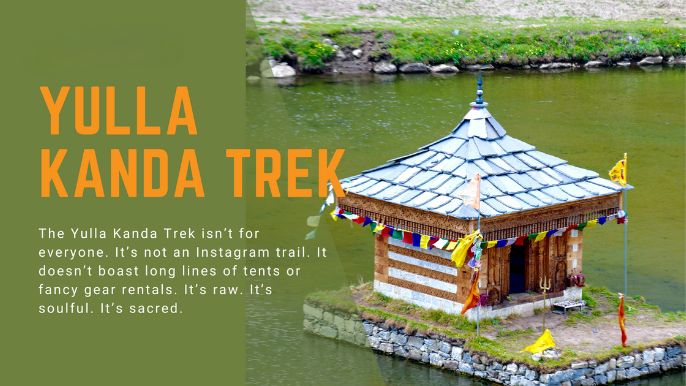Discover Paradise on Earth – Valley of Flowers Tour 2025
Published on July 04, 2025
Valley of flowers tour package, Nestled in the breathtaking Himalayas, the Valley of Flowers that truly lives up to its name. A dream destination for nature lovers, photographers, adventure enthusiasts, and peace seekers alike — this vibrant alpine meadow bursts into a riot of colors every summer. With our specially curated Valley of Flowers Tour Package , you can experience this natural wonder like never before.
Whether you're departing from Delhi , Rishikesh , Mumbai , or Haridwar , our flexible and well-planned Valley of Flowers Tour Packages ensure a seamless journey filled with comfort, safety, and unforgettable memories.
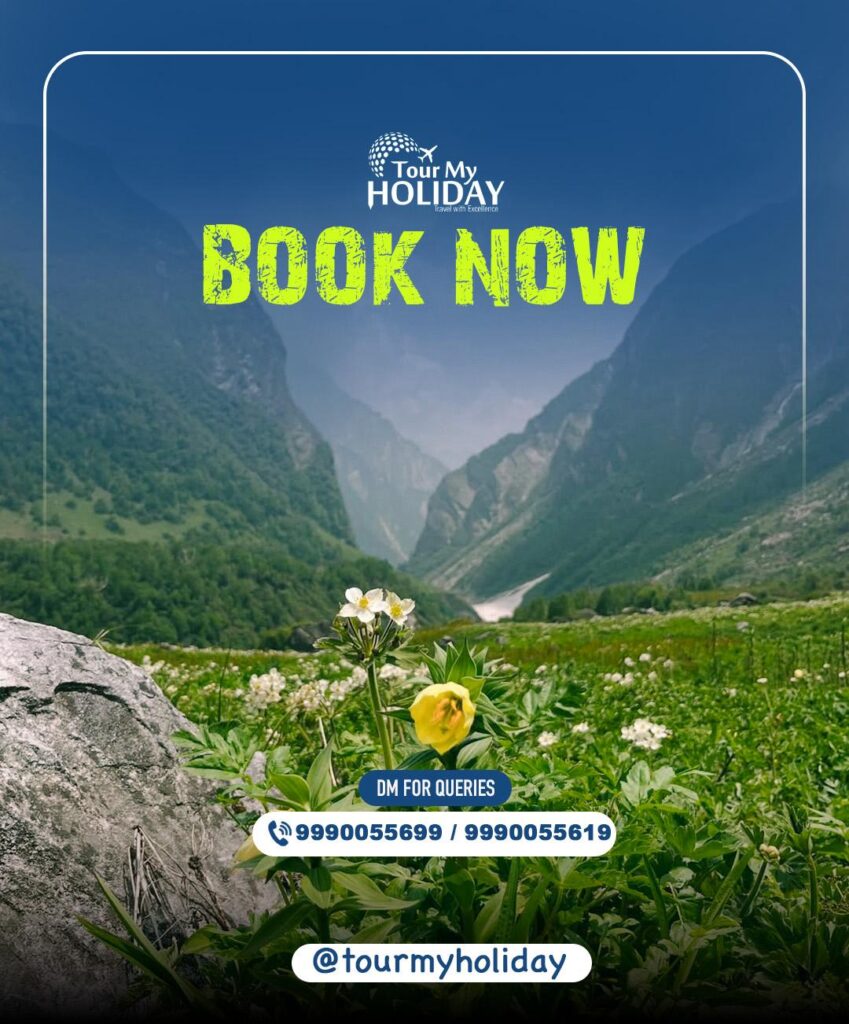
Valley of Flowers Tour Itinerary – 6 Days from Rishikesh
Embark on an unforgettable journey through nature’s paradise with our Valley of Flowers Tour Package from Rishikesh . This 6-day adventure combines scenic beauty, spiritual experiences, and moderate trekking, making it perfect for families, couples, solo travelers, and photography enthusiasts alike.
Let the magic of the Himalayas unfold as you traverse lush green valleys, alpine meadows, and sacred landscapes. Below is the complete day-wise itinerary of your expedition to the mesmerizing Valley of Flowers .
Day 1: Arrival in Rishikesh & Drive to Govindghat / Pipalkoti
- Arrive at Rishikesh , the yoga capital of the world, known for its serene vibes and spiritual energy.
- After breakfast, meet your tour representative at The 60s Cafe (The Beatles Café) — a nostalgic start point of your Himalayan journey.
- Begin your scenic drive towards Govindghat / Pipalkoti (approx. 280 km, 8–9 hours), passing through charming hill towns like Vikasnagar, Chinyalisaur, and Joshimath .
- En route, enjoy breathtaking views of snow-capped peaks, deep gorges, and flowing rivers like the Alaknanda and Pindar .
- On reaching Govindghat, check into your pre-booked accommodation.
- Rest and relax for the night, preparing for the trekking days ahead.
Overnight Stay: Govindghat / Pipalkoti

Day 2: Trek from Govindghat / Pipalkoti to Ghangaria (14 km / 7–8 hrs)
- Post an early breakfast, begin your ascent towards Ghangaria , a key base camp for trekkers heading to both the Valley of Flowers and Hemkund Sahib .
- The trail follows the Bhyundar Valley , winding through dense forests of rhododendron and oak, alongside the roaring Pushpawati River .
- Cross several small wooden bridges and witness cascading waterfalls and natural hot springs along the way.
- Reach Ghangaria , a quaint mountain village nestled between two glacial streams, and check into your guesthouse or dormitory.
- Spend the evening exploring the surroundings or relaxing in this tranquil setting.
Overnight Stay: Ghangaria
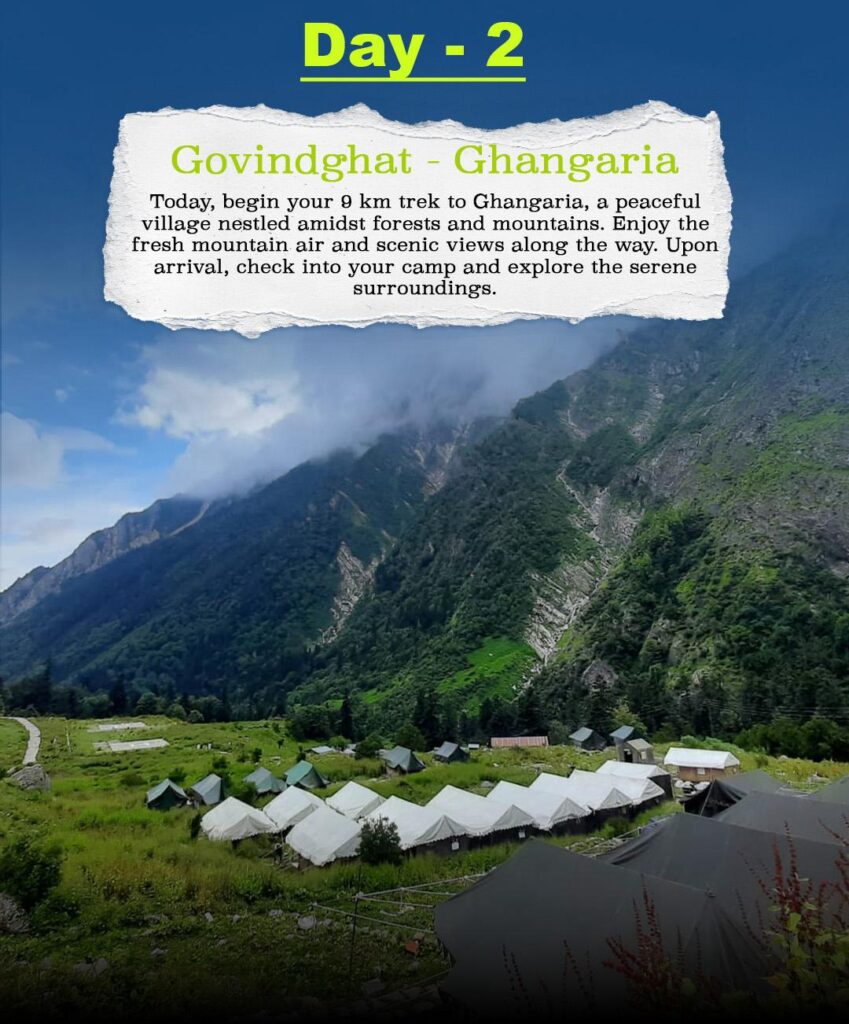
Day 3: Full-Day Exploration of Valley of Flowers
- Rise early and head out for the much-awaited visit to the Valley of Flowers , located about 3 km from Ghangaria.
- As you enter this UNESCO World Heritage Site, be mesmerized by a vibrant carpet of wildflowers in every shade imaginable — from dazzling reds and purples to soft pinks and yellows.
- Walk through the valley, soaking in the fragrance of alpine flora, and capturing stunning photographs of rare blossoms and butterflies fluttering around.
- Visit the Pushpavati River and enjoy a peaceful sit-down amidst nature.
- Return to Ghangaria in the afternoon for some rest.
- Optional: Visit the nearby Sindhu Ghati Park , another floral attraction slightly off the main trail.
Overnight Stay: Ghangaria
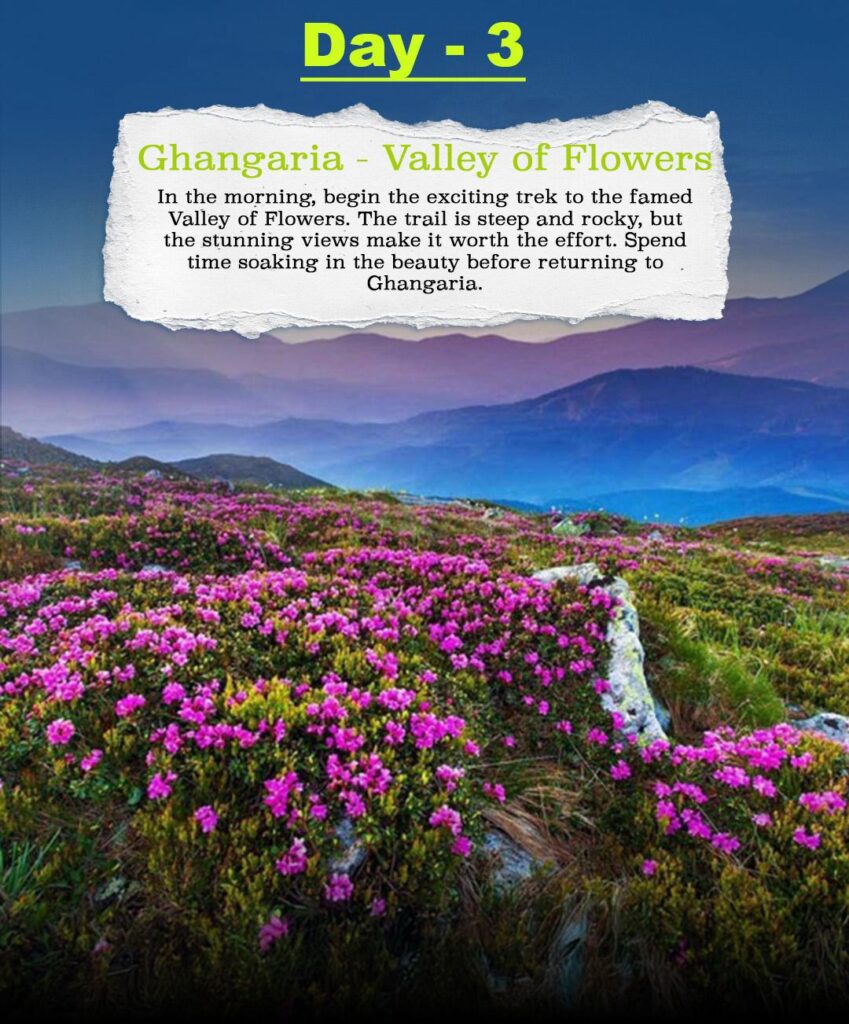
Day 4: Trek to Hemkund Sahib & Back to Ghangaria
- Wake up early and set off for the holy Sri Hemkund Sahib Gurudwara , situated at an altitude of 4,329 meters.
- The trek is steep and moderately challenging (approx. 6 km one-way), passing through rocky terrain and pine forests.
- Upon reaching the gurudwara, experience the spiritual serenity and marvel at the pristine glacial lake beside it.
- Spend time in prayer or simply absorbing the majestic views of surrounding peaks like Mount Nanda Devi .
- Descend back to Ghangaria in the afternoon, where you can unwind and prepare for the return journey.
Overnight Stay: Ghangaria
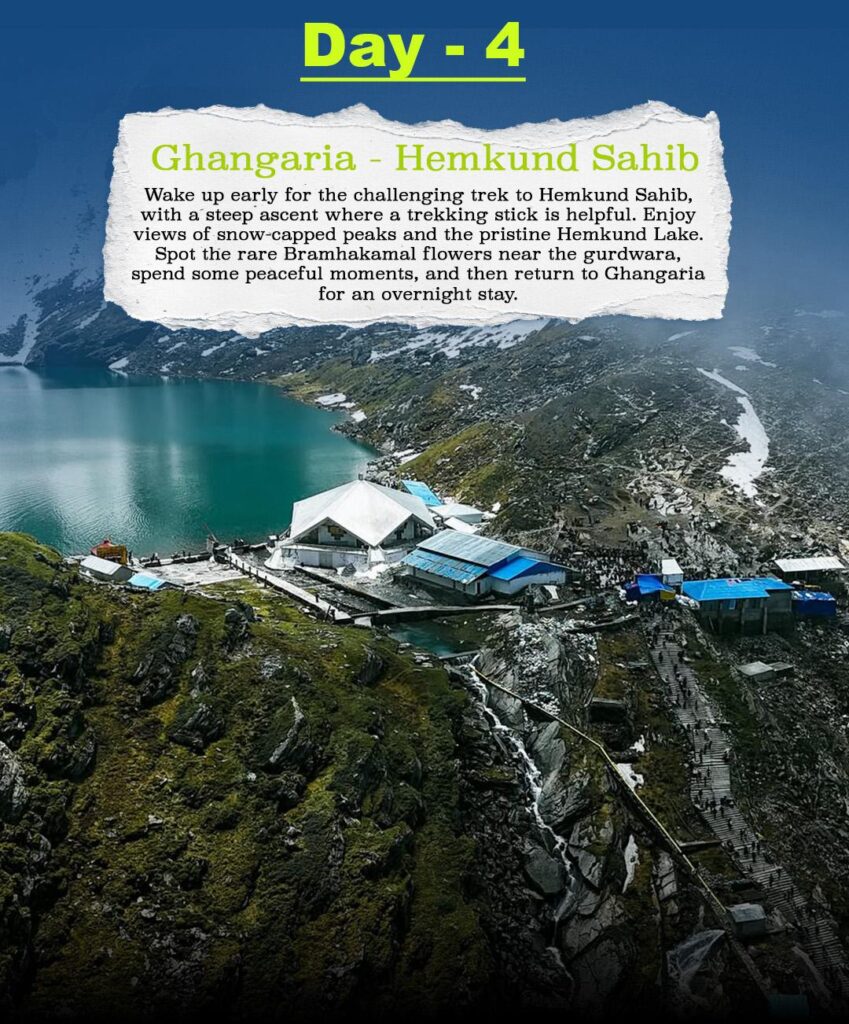
Day 5: Descent Trek from Ghangaria to Govindghat / Pipalkoti
- Today marks the end of your trekking days. Start your descent back to Govindghat / Pipalkoti .
- The downhill trek (approx. 14 km) is relatively easier and allows you to enjoy the panoramic views without the effort of climbing uphill.
- Take breaks at scenic spots, reflect on your Himalayan journey, and click last-minute pictures.
- On reaching Govindghat, board your waiting vehicle for a relaxing drive back to Rishikesh .
- Overnight halt en route or continue driving depending on time and road conditions.
Overnight Stay: On the way or reach Rishikesh late night (depends on traffic)
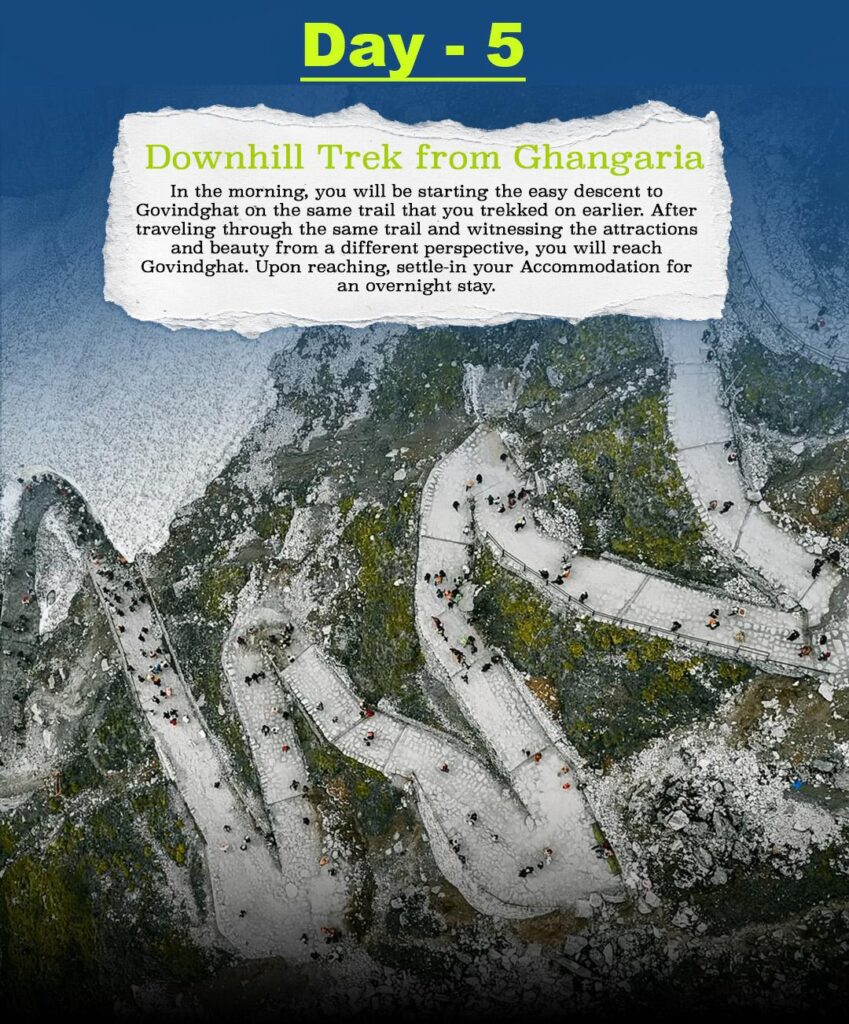
Day 6: Transfer to Rishikesh & Departure
- After a refreshing night’s sleep, proceed towards Rishikesh , concluding your soul-stirring Himalayan adventure.
- On arrival in Rishikesh, you may choose to explore local attractions like Lakshman Jhula , Triveni Ghat , or enjoy a peaceful session of meditation or yoga.
- Later, transfer to your onward destination — whether it’s the airport, railway station, or bus stand.
End of Tour
Highlights of Your Valley of Flowers Itinerary:
- Scenic drive from Rishikesh to the Himalayas
- Moderate trekking suitable for first-time trekkers
- Visit to the enchanting Valley of Flowers
- Spiritual experience at Hemkund Sahib Gurudwara
- Opportunity for photography, reflection, and rejuvenation
- Comfortable stays and expert guidance throughout

Why Choose Our Valley of Flowers Tour Package?
- ✅ Multiple Departure Points : Easy booking with packages available from Delhi , Rishikesh , Munsiyari , Haridwar , and even Mumbai .
- ✅ Romantic Escapes : Looking for a Valley of Flowers Tour Package for Couples ? We’ve got romantic itineraries designed for lovebirds seeking beauty and tranquility together.
- ✅ Expert Guidance : Enjoy hassle-free exploration with our Valley of Flowers Guided Tours led by experienced local trek leaders and naturalists.
- ✅ Trekking-Friendly Plans : Choose from a range of Valley of Flowers Trek Packages tailored for solo travelers, groups, families, and adventure seekers.
- ✅ Fixed Departures in 2025 : Plan your trip with confidence using our scheduled Valley of Flowers Fixed Departures , ensuring timely bookings and group convenience.
What’s Included in Our Valley of Flowers Tour Package?
- ✔️ Accommodation in hygienic guesthouses or comfortable hotels
- ✔️ All meals during the trek (veg & non-veg options available)
- ✔️ Transportation from key pickup points
- ✔️ Expert trek guides and support staff
- ✔️ Entry permits and forest charges
- ✔️ First aid kits and emergency services
Highlights of the Journey
- Trek through lush green meadows bursting with wildflowers
- Visit the sacred Hemkund Sahib Gurudwara en route
- Capture stunning landscapes perfect for photography
- Experience the serenity of untouched Himalayan nature
- Explore rare flora and fauna found only in high-altitude regions

Weather Wonders of the Valley of Flowers: A Seasonal Journey Through Nature’s Playground
Nestled high in the Himalayas, the Valley of Flowers is not just a visual spectacle — it’s a place where nature dances to the rhythm of seasons. The weather in the Valley of Flowers plays a pivotal role in transforming this alpine paradise into a living canvas of color, fragrance, and serenity.
Understanding the climate and weather conditions can help you plan your visit perfectly and ensure you witness this UNESCO World Heritage Site at its most magical.
Best Time to Visit: Summer Blooms (June to September)
As winter loosens its icy grip, the Valley of Flowers awakens from its snowy slumber. From mid-June to early October , the region experiences pleasant summer weather , with temperatures ranging between 10°C and 20°C during the day.
- Altitude: Around 3,600 meters above sea level
- Weather: Cool and crisp mornings, mild afternoons
- Sky Conditions: Mostly clear skies with occasional afternoon clouds
This is when the valley bursts into life — a riot of colors as millions of wildflowers bloom across the meadows. It's the peak season for travelers, trekkers, and photographers alike.
Winter Wonderland (October to May): Nature’s Quiet Retreat
From October onwards , the Valley of Flowers is blanketed under heavy snowfall, making it inaccessible to tourists. During these months:
- Temperatures: Can drop to -5°C at night , with icy winds sweeping through the mountains
- Snowfall: Heavy and continuous from December to March
- Accessibility: Completely closed due to snow blockades
While the cold makes it inhospitable for regular visitors, it transforms the landscape into a surreal, white paradise — ideal only for experienced mountaineers and researchers.
Monsoon Magic: July – August
July and August bring light to moderate rainfall , adding a mystical charm to the region. Though the trails can become slippery and muddy, the valley looks its lushest during this time.
- Rainfall Pattern: Occasional showers, mostly in the afternoon or evening
- Humidity: Moderate
- Caution: Landslides and roadblocks are possible on the route from Rishikesh or Haridwar
Despite the challenges, many nature lovers prefer visiting in early monsoon to enjoy fewer crowds and ethereal beauty.
What to Pack Based on Valley of Flowers Weather?
- Light woolens & thermal wear even in summer (nights get chilly)
- Waterproof trekking shoes for wet or muddy trails
- Raincoat or poncho during monsoon season
- Sunscreen, sunglasses, and cap — UV rays are strong at high altitudes
- First aid kit, trekking pole, and water bottle for comfort on the trail

A Night in the Clouds: Discovering Accommodations in the Valley of Flowers
While the Valley of Flowers is best known for its breathtaking beauty and floral splendor, finding the right place to rest your head at the end of a long trek is just as important as the journey itself. Though not a typical luxury destination, the accommodations near this Himalayan paradise offer comfort, simplicity, and a deep connection with nature .
Unlike bustling hill stations, the lodging options in and around the Valley of Flowers are minimal — designed to preserve the tranquility and ecological balance of this UNESCO World Heritage Site. Here’s what you can expect during your stay:
Where You’ll Stay: Ghangaria – The Gateway to Paradise
The only major accommodation hub near the Valley of Flowers is Ghangaria , a small mountain village located about 3 km from the valley. Nestled at an altitude of 3,050 meters, Ghangaria serves as a base camp for trekkers heading to both the Valley of Flowers and Hemkund Sahib .
Due to its remote location and protected environment, Ghangaria offers eco-friendly, basic yet clean and comfortable stays , including:
- Government-run guesthouses
- Private lodges and dormitories
- Religious pilgrim rest houses (Dharamshalas)
- Eco-camps (seasonal)
These accommodations are often run by locals and managed with sustainable practices in mind.
What to Expect: Simple Comfort Amidst Nature
While the facilities may not be luxurious, they provide all the essentials for a peaceful and rejuvenating stay:
- Twin-sharing rooms with attached or common washrooms
- Heating arrangements like room heaters or hot water bags during early season
- Meals included in most packages – usually vegetarian, with occasional non-veg options
- Basic electricity supply (limited hours in some places)
- No mobile network or Wi-Fi in most lodges – ensuring a digital detox and deeper immersion in nature
Many travelers find that these rustic accommodations enhance the charm of the experience, offering a rare opportunity to disconnect from modern life and reconnect with nature.
Dining Experience: Local Flavors & Trekker-Friendly Meals
Most accommodations serve simple, hearty meals suited to trekkers’ needs. Typical food includes:
- Hot breakfasts of parathas, eggs, tea, and porridge
- Wholesome lunches and dinners featuring dal, rice, sabzi, and chapatis
- Occasional Maggi or noodle breaks for comfort food lovers
- Fresh local produce when available
Since the region is high-altitude and difficult to access, fresh ingredients are limited, but the warmth and hospitality of the hosts make every meal memorable.
Tips for Booking Accommodation in Ghangaria
- Book in advance , especially during peak season (June to September), as availability is limited.
- Carry a sleeping bag or light blanket for extra warmth, especially in June or September.
- Pack a torch or headlamp , as power cuts are common.
- Carry dry snacks and energy bars for the trek and late-night cravings.
- Be respectful of local customs and environmental guidelines — littering or disturbing nature is strictly prohibited.

Trailblazing Beauty: Adventure Activities to Experience in the Valley of Flowers
While the Valley of Flowers is famously known for its mesmerizing floral landscapes and spiritual significance, it also serves as a gateway to high-altitude adventure and immersive outdoor experiences. Nestled in the Garhwal Himalayas , this UNESCO World Heritage Site isn’t just a visual treat — it’s a haven for trekkers, explorers, and nature enthusiasts seeking a blend of serenity and adrenaline.
Here are some unforgettable adventure activities you can enjoy during your visit:
1. Trekking Through Nature’s Gallery
The Valley of Flowers trek itself is an adventure like no other. Ranging from moderate to adventurous , the trail begins from Govindghat or Pipalkoti , passing through lush forests, gushing streams, and alpine meadows before reaching the colorful valley.
- Distance: Approx. 14 km from Govindghat to Ghangaria (base camp)
- Altitude: ~3,600 meters at the valley
- Duration: 6–8 hours on Day 2 of most itineraries
What makes this trek special is the ever-changing landscape — from rhododendron woods to snow-fed rivers — offering both physical challenge and soul-soothing beauty.
2. Pilgrimage & High-Altitude Ascent to Hemkund Sahib
Just a short trek away from the Valley of Flowers lies Sri Hemkund Sahib Gurudwara , one of the highest Sikh shrines in the world. The ascent to this sacred site is not only spiritually uplifting but also physically demanding.
- Distance: 6 km uphill from Ghangaria
- Altitude: 4,329 meters above sea level
- Highlights: Crystal-clear glacial lake, panoramic mountain views, and serene ambiance
This trek tests your endurance with steep climbs and rocky terrain, rewarding you with breathtaking vistas and a sense of achievement that lasts a lifetime.
3. Nature Photography Amidst Wild Blooms
For photography lovers, the Valley of Flowers is a dream come true. With over 600 species of alpine flowers , the valley transforms into a living canvas every summer — a paradise for macro and landscape photographers alike.
- Best Time for Photography: July to August when the blooms are at their peak
- Popular Subjects: Rare orchids, Himalayan butterflies, glacial streams, and cloud-kissed peaks
- Tip: Visit early morning or late afternoon for golden-hour lighting and fewer crowds
Whether you're using a DSLR or smartphone, every frame here feels like a masterpiece.
4. Bird Watching in the Bhyundar Valley
The surrounding areas of the Valley of Flowers, especially near Ghangaria , are home to a variety of high-altitude birds. This lesser-known activity allows travelers to observe Himalayan avian species in their natural habitat.
- Common Birds Seen: Himalayan Monal, Snow Pigeon, Blue Whistling Thrush, and various finches
- Best Spots: Near the Pushpawati River and forested trails around Ghangaria
- Ideal For: Wildlife enthusiasts, bird photographers, and peaceful nature lovers
Carry binoculars and a field guide if you’re serious about spotting rare species!
5. Exploring Glacial Streams and Waterfalls
As you trek through the Bhyundar Valley , you’ll encounter cascading waterfalls, icy streams, and natural hot springs. These make for perfect rest stops and photo ops.
- Must-See Spots:
- Brahma Kamal Pool
- Pushpawati Falls
- Hot Spring near Govind Chatti
These natural wonders add a refreshing touch to your journey and offer moments of quiet reflection amid the mountains.
6. Overnight Camping in the Himalayas
Though accommodations in Ghangaria are basic, some adventure groups and local guides offer seasonal camping options near the valley entrance or in nearby meadows.
- Experience: Sleeping under starlit skies, waking up to misty mornings, and bonding around bonfires
- Eco-Friendly: Most camps follow sustainable practices to protect the fragile ecosystem
- Perfect For: Couples, solo travelers, and small groups looking for a rustic yet magical experience
Camping here lets you disconnect from the digital world and reconnect with nature at its purest.
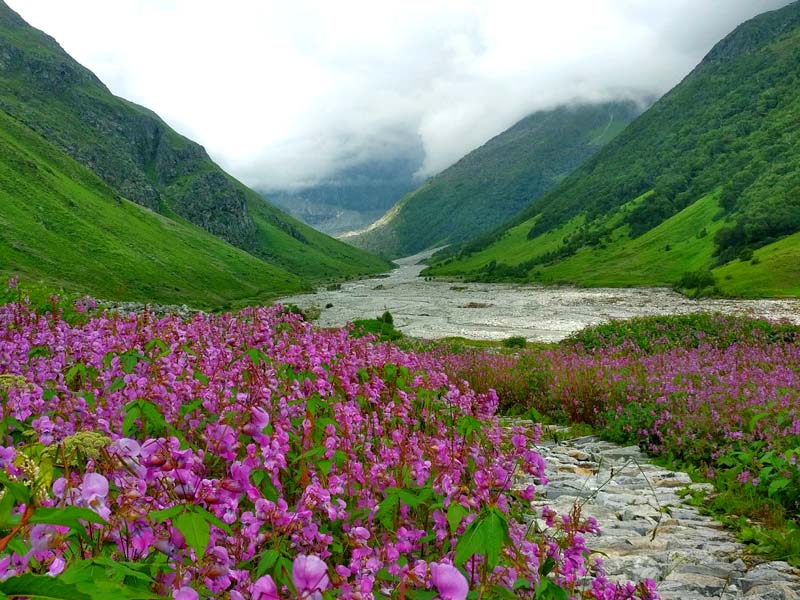
A Journey Into Eden: My Honest Review of the Valley of Flowers
If you’ve ever wondered what paradise might look like, look no further than the Valley of Flowers in Uttarakhand. Nestled high in the Himalayas, this UNESCO World Heritage Site is not just a destination — it’s an experience that stays with you long after you’ve returned home.
I had the privilege of visiting the Valley of Flowers last summer, and I can confidently say it was one of the most magical experiences of my life. From the moment I stepped into this alpine wonderland, I felt as though I had entered a dream painted in every shade of color imaginable.
The First Glimpse: Nature at Its Finest
The trek to the valley begins from Ghangaria , a small mountain village that serves as the base camp. After a full day of walking through lush forests, crossing gushing streams, and navigating rocky trails, the first view of the valley left me speechless.
It stretched out before me like a living carpet — a sea of wildflowers swaying gently in the cool mountain breeze. There were blossoms in every hue — deep purples, vibrant reds, soft pinks, and golden yellows — all thriving in perfect harmony. I couldn’t help but feel humbled by the sheer scale and beauty of it all.
The Trek: Challenging Yet Rewarding
While the journey isn’t easy — especially with the altitude and uneven terrain — it’s absolutely worth every step. The trail from Govindghat to Ghangaria (about 14 km) is moderately difficult but manageable for anyone with average fitness. The real reward comes on Day 3 when you finally enter the valley itself.
What surprised me was how peaceful the entire experience was. No honking cars, no digital distractions — just the sound of birds chirping, bees buzzing, and the occasional rustle of wind through the tall grasses.
Beyond the Valley: Hemkund Sahib Adds Depth to the Trip
A short uphill trek from Ghangaria leads to Hemkund Sahib , one of the highest Sikh shrines in the world. While the climb was tough, reaching the gurudwara felt like touching the sky. Surrounded by snow-capped peaks and a mirror-like glacial lake, the spiritual aura here is overwhelming. Even if you're not religious, the serenity of this place will leave a lasting impression.
A Photographer’s Paradise
For photography enthusiasts like myself, the Valley of Flowers is nothing short of heaven. Every corner offers a new frame — be it a close-up of rare orchids, a wide-angle shot of the valley bathed in morning light, or a candid capture of fellow trekkers lost in awe. Early mornings and late afternoons are especially magical, with soft golden light casting dreamy shadows across the meadows.
Stay & Food: Simple, Humble, and Heartfelt
Accommodation in Ghangaria is basic — think shared rooms, limited electricity, and no Wi-Fi — but that’s part of the charm. Most lodges are run by locals who welcome you with warmth and serve hearty vegetarian meals made with fresh ingredients. Dal, rice, sabzi, and steaming cups of ginger tea became my comfort foods during those chilly nights.
There’s something deeply grounding about sleeping under starlit skies without any modern distractions — a rare luxury these days.

Quick Tips Based on My Experience:
- Best Time to Visit: June to September
- Altitude: ~3,600 meters
- Difficulty Level: Easy to moderate trek
- What to Carry: Warm clothes, sturdy shoes, water bottle, camera, and a curious heart
- Permits Required: Yes (can be arranged locally or through your tour operator)
From Secret Sanctuary to World Wonder: The Fascinating History of the Valley of Flowers
Tucked away in the high-altitude Himalayas of Uttarakhand, the Valley of Flowers is more than just a visual marvel — it has a rich and intriguing history that spans centuries. Once hidden from the world and known only to local shepherds and pilgrims, this alpine paradise has journeyed from obscurity to global recognition as a UNESCO World Heritage Site .
Here’s the story of how this floral haven was discovered, cherished, and protected over time.
Discovery by Chance: A British Explorer’s Lucky Encounter
The modern world first came to know about the Valley of Flowers in 1931 , thanks to a chance discovery by a British explorer named Frank S. Smythe . While returning from a successful expedition to Mount Kamet, Smythe and his team were forced to take shelter due to bad weather. During this detour, they stumbled upon a vast meadow bursting with wildflowers unlike anything they had ever seen.
Intrigued and inspired, Smythe returned to the valley a few years later and wrote about his experience in a book titled “The Valley of Flowers” (published in 1938). His vivid descriptions and photographs introduced this hidden gem to the Western world and sparked interest among botanists, explorers, and nature lovers globally.
Early Explorers & Botanical Curiosity
Before Smythe’s visit, the valley was known to local Garhwali shepherds who occasionally grazed their livestock in its lush meadows during the summer months. However, due to its remote location and lack of accessibility, it remained largely untouched and unexplored by outsiders.
After Smythe’s writings, the valley became a subject of scientific curiosity. Botanists and researchers began visiting the region to study its unique flora, which includes rare and endangered species like the Brahma Kamal , Himalayan Blue Poppy , and various types of orchids and primulas.
Spiritual Legacy: A Sacred Landscape
Beyond its natural beauty, the Valley of Flowers holds deep spiritual significance. It lies close to the sacred Hemkund Sahib Gurudwara , one of the highest Sikh shrines in the world. Pilgrims traveling to Hemkund Sahib often pass through the valley, adding a spiritual dimension to its allure.
Local legends also associate the area with ancient Hindu mythology, suggesting that the flowers of the valley might have been used by Lord Hanuman to heal Lord Rama’s brother, Lakshmana, during the epic Ramayana era. Though these tales are symbolic, they add to the valley’s mystique and reverence.
Conservation Efforts & UNESCO Recognition
As the popularity of the Valley of Flowers grew, so did concerns about environmental degradation and unsustainable tourism. To preserve its fragile ecosystem, the Indian government declared the area a National Park in 1982.
In 1988 , the park was included under the Project Tiger initiative , not because tigers inhabit the region, but to extend conservation efforts to protect the broader Himalayan ecosystem.
Then, in 1988 , along with the Nanda Devi National Park , the Valley of Flowers was jointly designated a UNESCO World Heritage Site under the Natural Heritage category , recognizing its ecological importance and biodiversity.
Today, access to the valley is carefully regulated, with restrictions on group sizes, camping, and littering to ensure minimal human impact on its pristine environment.
Legacy of Preservation and Exploration
Over the decades, the Valley of Flowers has continued to attract scientists, photographers, writers, and spiritual seekers. It remains a symbol of untouched natural beauty and a reminder of the need to protect such spaces for future generations.
Its history — from being a secret Himalayan treasure to a globally celebrated destination — reflects the delicate balance between exploration and conservation, tradition and modernity, mystery and revelation.

The Valley Remembers: A Final Word on Nature’s Masterpiece
As we bring this journey to a close, one truth remains — the Valley of Flowers tour package is more than just a destination; it is a feeling, a memory etched in petals and mountain winds.
It is the laughter of trekkers echoing through meadows, the silent prayers offered at Hemkund Sahib, the click of a camera capturing fleeting blooms, and the quiet awe of standing amidst something far greater than oneself.
This Himalayan haven has been discovered, written about, photographed, and protected — yet it still holds secrets in its soil, stories in its streams, and serenity in every swaying stem.
Visiting the Valley of Flowers isn’t just a trip; it’s a reminder of Earth’s untouched beauty, of the importance of preserving such wonders, and of how deeply nature can move the human soul.
So whether you’ve walked its trails or only dream of doing so, remember this: the valley waits patiently, blooming anew each summer, ready to welcome those who seek peace, adventure, or simply a moment of pure wonder.
Frequently Asked Questions:
1. What makes the Valley of Flowers so special compared to other trekking destinations?
The Valley of Flowers is renowned for its unmatched natural beauty, rich biodiversity, and serene environment. Unlike typical mountain treks, this alpine meadow bursts into a kaleidoscope of wildflowers every summer — home to over 600 species of flora, some of which are rare and endangered. It is also spiritually significant due to its proximity to Hemkund Sahib.
2. Is the Valley of Flowers suitable for first-time trekkers?
Yes. The trek from Ghangaria to the Valley of Flowers is considered moderate in difficulty, making it accessible even to beginners with average fitness. However, acclimatization to high altitude (around 3,600 meters) is important.
3. When is the best time to visit the Valley of Flowers?
The ideal time to visit is between mid-June and mid-October, when the flowers are in full bloom. July and August are peak months for vibrant colors, while September offers fewer crowds and cooler temperatures.
4. Are there any accommodations inside the Valley of Flowers?
There are no accommodations inside the valley itself. The nearest place to stay is Ghangaria, located about 3 km away. Ghangaria offers basic but clean guesthouses, eco-lodges, and dormitory-style stays managed by local authorities and private operators.
5. Do I need a permit to enter the Valley of Flowers?
Yes, all visitors require a permit to enter the Valley of Flowers National Park. These can be obtained at the entry gate in Ghangaria or arranged through your tour operator. Indian nationals and foreign tourists have separate entry fees.
6. How do I reach the Valley of Flowers from Delhi or Rishikesh?
From Delhi, you will drive to Govindghat / Pipalkoti via Haridwar and Karnaprayag (~280–300 km). From Rishikesh, the distance is similar. From there, it is a 14-km trek to Ghangaria, followed by a 3-km walk to the valley.
7. Is mobile network or internet available in the Valley of Flowers region?
Mobile network coverage is limited or non-existent once you leave Govindghat. In Ghangaria and parts of the trail, you may get BSNL connectivity, but other networks often don’t work. Internet access is not available.
8. Can couples or families visit the Valley of Flowers together?
Absolutely. The Valley of Flowers is a great destination for families, couples, and solo travelers alike. With proper planning and a moderate pace, even children and elderly members can enjoy the experience.
9. What kind of wildlife can I expect to see in the Valley of Flowers?
While large animals are rare due to high altitude, the area is rich in birdlife and small mammals. You might spot birds like the Himalayan Monal, Snow Pigeon, and various types of finches. If lucky, you might catch a glimpse of the elusive Blue Sheep (Bharal) in nearby areas.
10. Why is the Valley of Flowers a UNESCO World Heritage Site?
The Valley of Flowers National Park was declared a UNESCO World Heritage Site in 1988 due to its exceptional natural beauty, unique alpine flora, and ecological importance. It plays a crucial role in conserving high-altitude ecosystems and serves as a habitat for several rare and endangered species.
.jpeg)
